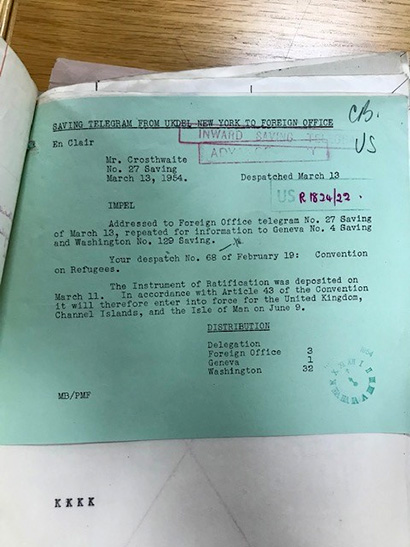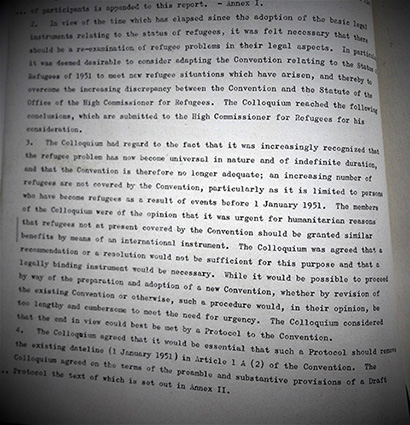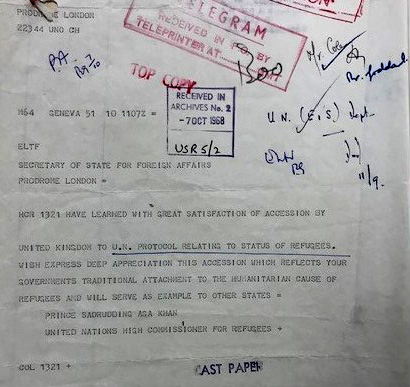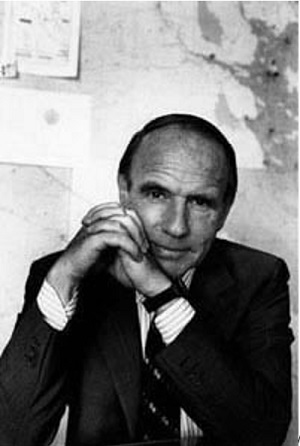The 28th of July 2021 marks the 70th anniversary of the United Nations’ 1951 Convention relating to the Status of Refugees. Through this Convention, states agree a basic principle – that a refugee should not be returned to a country where they face serious risks to their life or freedom.
In some ways the definition of a refugee seems quite simple: any person who has been forced to leave their home and seek sanctuary due to persecution. However, the histories of the 1951 UN Convention on Refugees, and the later 1967 UN Protocol on the Status of Refugees, are interesting ones in The National Archives and reflect a period in which global migration, political stability and human rights had to be radically reimagined.
The word ‘refugee’ was first used in English to describe the arrival of the Huguenots in Britain – Protestants who were fleeing from Catholic France in the 17th century. From that time the term was applied regularly to those seeking shelter from war or other kinds of violence. However, the word was generally applied to specific groups of migrants. By the end of the Second World War, international co-operation on the issue of refugees was well established through organisations such as the League of Nations, and later the International Refugee Organisation. Yet to qualify for their attention you had to be a member of a community or group that was on their ‘list’.
At the end of the Second World War, it seemed to many that decades of political and social upheaval was at an end, and that with it would end the ‘refugee problem’. Yet within less than 30 years, the start of the Cold War and the dismantling of European empires, including the British Empire, had generated waves of new migrants seeking political and religious asylum around the globe. Through this period of change, between 1951 and 1967, new political and legal discussions eventually generated a new ‘universal’ definition of a refugee, one that might apply to any individual regardless of where they are from. Here below is a selection of three documents from the archives that give us insight into how that new definition emerged.
1951 – the Convention relating to the Status of Refugees
In 1946 it was calculated that there were 1,250,000 refugees in Europe created by the upheaval of the Second World War, and the stirrings of the Cold War. By 1943 there were attempts to imagine how to manage this displacement through the Intergovernmental Committee on Refugees, by the Fifth Plenary Session committee in 1945; the main topic of discussion was the UK’s proposal that the newly formed UN should set up a body for refugee work.

By 1951 the UN had drafted a Convention that, as a Foreign Office memo records, was ‘described as a Magna Carta for refugees’[ref]Memo prepared by the Foreign Office, 15/01/1952. Catalogue ref: FO 371/112630.[/ref]. This new Convention, covered ‘an unprecedentedly large number of categories of refugees’ and established ‘a wide range of minimum rights’[ref]Memo prepared by the Foreign Office, 15/01/1952. Catalogue ref: FO 371/112630.[/ref]. This included the principle that refugees should not be treated ‘less favourably than other foreign aliens’ (as immigrants were called at the time)[ref]Memo prepared by the Foreign Office, 15/01/1952. Catalogue ref: FO 371/112630.[/ref].
Yet the focus of the Convention was very squarely focused on the Second World War. The definition of refugee only included those who were seeking asylum as a result of events occurring before 1 January 1951. The Convention also focused on refugees produced by ‘events occurring in Europe before 1 January 1951’ although states could opt for a broader definition of ‘events occurring in Europe or elsewhere’[ref]The wording of the Convention can be found on the website of the UN High Commission for Refugees (UNHCR).[/ref].
Although the UK government was broadly enthusiastic about the Convention and committed to its terms, integrating the Convention into UK law was not a straightforward process.
The government also needed to secure agreement from various parts of British home and imperial territory that were run under different policy and law. The Scottish, Welsh and Northern Irish governments needed to give their agreement separately, as did the Channel Islands and the Isle of Man. The colonies under British rule also needed to be consulted on refugee law. The British Nationality Act, 1948 had given all the status of Citizens of the United Kingdom and Colonies to all those under ‘British Protection’ across the British Empire. Some colonial governments had expressed their ‘willingness to accept the Convention without reservation’ but others would not accept it, or proposed adaptations to its terms that were different than those required in the UK[ref]Letter from the Colonial Office to the Foreign Office. 23/03/1954. Catalogue ref: FO 371/112630.[/ref].
In 1954 the government decided to pursue this new international agreement without having fully worked out the position of the colonies. The Convention, the Foreign Office suggested, could be extended to colonial territories ‘from time to time’, ‘as and when’[ref]Memo prepared by the Foreign Office, 15/01/1952. Catalogue ref: FO 371/112630.[/ref]. With that decision made the UK deposited the ‘instrument of ratification’ with the UN on 11 March 1954, and it entered into force in the UK on 9 June.
1965 – rethinking the ‘refugee problem’
By 1965, it had become very clear that the 1951 Convention was insufficient in a post-war world that continued to be turbulent. The post-war era was not producing an increase rather than a decrease in forced migration. In Europe, international programmes to help refugees had met with some success. By 1966 the number of those displaced by the Second World War and who still had yet to be settled had been reduced to only around 12,000, without about 500 of those still living in camps[ref]Briefing to the Prime Minister, 06/1966. Catalogue ref: PREM 13/1250.[/ref].

Although there were still new influxes of refugees into Europe, the situation was relatively stable. On the other hand, new and massive displacements of people were taking place in other parts of the world. The UN had set up a special office for Palestinians who were displaced by the new Israeli state (UNRWA) in 1949, but the number of refugees there was still increasing. Even more pressing was the spiralling number of refugees on the African continent, which had risen from 32,000 in 1963, to 116,000 in 1965. In total the UN Refugee Agency now estimated the number of refugees in Africa and Asia to be 3 million[ref]Briefing to the Prime Minister, 06/1966. Catalogue ref: PREM 13/1250.[/ref].
In 1965 a meeting was organised in Italy for experts from around the world. As the report of the meeting sadly summarised, ‘the refugee problem has now become universal in nature and of indefinite duration, and … the Convention is therefore no longer adequate’[ref]Report on a colloquium held in 21-28 April 1965, at Bellagio, Como on ‘The Legal Aspects of Refugee Problems’ organised by the Carnegie Endowment for International Peace, with the support of the Swiss Government. Catalogue ref: FO 371/183305.[/ref]. The experts discussed the historical context and a range of possible responses to the growing problem. Following those experts’ advice and with consultation and discussion with various bodies of the UN, a new draft ‘Protocol’ was produced that would amend the Convention and would take into account the new ‘universality’ of the refugee experience.
1967 – the universal ‘refugee’
On 4 September 1968, the UK acceded to the UN Protocol Relating to the Status of Refugees. The telegram below from the UN High Commissioner for Refugees, Prince Sadruddin Aga Khan, marked the Prince’s appreciation of that new commitment by the UK to support refugees.

After becoming UN High Commissioner for Refugees in 1966, Prince Sadruddin prioritised visiting the UK. By 1968 he had met with a variety of UK-based voluntary organisations, as well as the Prime Minister Harold Wilson and The Queen. These meetings indicate the important role the UK had taken in promoting international co-ordination of responses to refugee problems. In 1966 the UK’s contribution to the UN Refugee Agency was the second largest after United States, and made up more than 7% of the funding the agency received from national governments[ref]Briefing to the Prime Minister, 06/1966. Catalogue ref: PREM 13/1250.[/ref].
The UK government had looked favourably on the extension of the definition of ‘refugee’ in the new UN protocol. However, implementing the Protocol in the UK again required consultation with the various dependencies that might be affected.
The shrinking of the British Empire in the late 1950s and early 1960s meant that by 1967 the number of territories under British colonial rule was vastly fewer than when the Convention was drafted in 1951. Eswatini (Swaziland) in Southern Africa preferred to wait to join the Protocol and negotiate with the UN once it became an independent state (as it did later that year). The UK refused to make any commitment to the Protocol on behalf of Southern Rhodesia (later Zimbabwe), which had unilaterally declared independence in 1965[ref]Note by Eric Goddard of the UN Economic and Social Department in the Foreign Office, 02/08/1968. Catalogue ref: FCO 61/475.[/ref]. However, the remaining dependent territories agreed. Once these discussions had taken place, and the Protocol had been presented to Parliament, the UK registered its accession with the Burmese UN Secretary General, U Thant, on 4 September 1968.

From that point onward the legal meaning of the term ‘refugee’ in UK law has no longer been limited to those who belong to a particular group, or who have been displaced during a particular incident. Since 1967 the agreed definition has included any person who ‘owing to well-founded fear of being persecuted for reasons of race, religion, nationality, membership of a particular social group or political opinion, is outside the country of his nationality and is unable or, owing to such fear, is unwilling to avail himself of the protection of that country; or who, not having a nationality and being outside the country of his former habitual residence as a result of such events, is unable or, owing to such fear, is unwilling to return to it’[ref]The wording of the Protocol can also be found on the website of the UN High Commission for Refugees (UNHCR).[/ref].
These two benchmarks – the 1951 Convention and the 1967 Protocol – were both huge moments in the history of human rights: they marked the change from a ‘list approach’ to defining refugees to a universal definition. Over the 70 years since 1951, these agreements have allowed the creation of international law and agencies to support people who have been forcibly displaced. They have made a difference to millions.
For those who are interested in researching the histories of individual refugees in the UK, please take a look at the research guide to our archives which is available here.
The library at The National Archives in Kew also has a number of resources available on site including books, reports and electronic resources. For an overview of these see the following bibliographies in the library catalogue:
well done archivists. The series of explorations is fabulous and a great way to recognise the importance of archives to the many philistines in our society. Same for the Windrush blog.